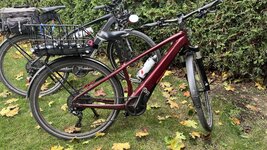Hello everyone,
This is my first post please bear with me. I have a family relative that did a LOT of cycling in her years and she is about to be 70 years old soon. She is a very adept cyclist.
To make a long story short, every since she purchased her 2020 Turbo Vado 4.0, she has found it too slow on descents and in the flats. She says ‘I am running out of gears I want to go faster’ . The bike is this one: 2020 Turbo Vado 4.0. Yes equipped with dog pannier and all.
I unfortunately do not know which options there are for a larger 104 BCD chainring (how many teeth does it have at the present I do not know.)
I am trying to help out by buying a few chainrings for her mechanically-adept husband to install and for them to try. Do not know about impact of larger chainring on the motor.
Does it make any sense? Any ideas or comments?
Thank you
Ps: also researching changing bike outright to creo2 e5 but it is a longshot.
This is my first post please bear with me. I have a family relative that did a LOT of cycling in her years and she is about to be 70 years old soon. She is a very adept cyclist.
To make a long story short, every since she purchased her 2020 Turbo Vado 4.0, she has found it too slow on descents and in the flats. She says ‘I am running out of gears I want to go faster’ . The bike is this one: 2020 Turbo Vado 4.0. Yes equipped with dog pannier and all.
I unfortunately do not know which options there are for a larger 104 BCD chainring (how many teeth does it have at the present I do not know.)
I am trying to help out by buying a few chainrings for her mechanically-adept husband to install and for them to try. Do not know about impact of larger chainring on the motor.
Does it make any sense? Any ideas or comments?
Thank you
Ps: also researching changing bike outright to creo2 e5 but it is a longshot.

